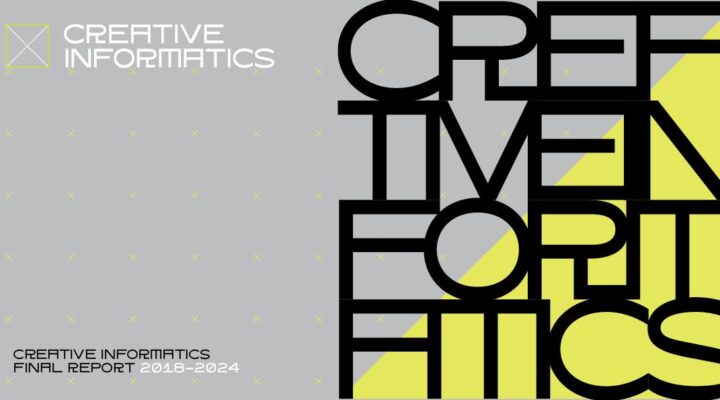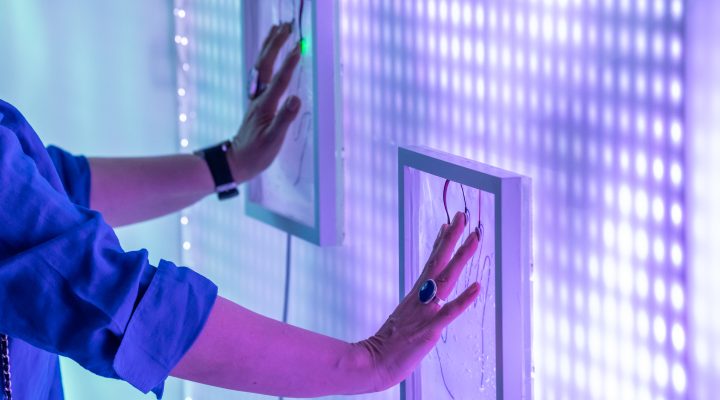
OVRA (Subjective Orientation in VR Audio) establishes a method for capturing listeners’ experiences of spatial audio in VR. Supported by a Creative Informatics Small Research Grant, Research Associate Ethan Robson reflects on the outcomes of the project.
NEWS | ETHAN ROBSON 24 AUGUST 2023
SUMMARY
This project investigated how, when in a Virtual Reality (VR) environment, binaural presentation of sound could be effectively captured and analysed. The stimuli (sounds) played to the participants were processed and synthesised to identify if pitch changes correspond to perceived movement in a 3D virtual space. The project is a development on a current study conducted by Dr Julián Villegas and Camilo Arevalo from the University of Aizu. These experiments have been repeated at Edinburgh Napier University by Ethan Robson and Dr Iain McGregor. Comparing and contrasting the results from both studies will improve the efficacy of the project. The results of the project have many applications, by applying spatial audio cues to important aspects of a situation, improving awareness for end-users. In circumstances where spatially identifying the source of a sound is paramount, such as with emergency services, the results of this project could be utilised in providing end-users with enhanced auditory awareness. The project aims to provide a strong dataset to refine and validate the method used in Aizu, and to show a level of measurable consistency between listeners in respect of height cues.
KEY ACTIONS AND EVENTS
Fifty participants were recruited from staff and students at Edinburgh Napier University. During the experiment, the procedure was explained before the practice session began. In the practice part, each participant was given the VR headset and headphones to wear, then a hand-held controller (see Fig. 1). A brief example of how the experiment operated was then disclosed, after which the participants were given the opportunity to ask questions about anything they did not understand. Once the participants were satisfied that they understood the instructions, had agreed to the consent form, and provided confirmation of their understanding, the main phase of the experiment began.
The project was presented at the Creative Informatics small grants and PhD RA showcase in October 2022 as a short talk on the project’s impact, methods, and initial findings. At Edinburgh Napier University’s Driving Forward research exhibition, the SOVRA project was exhibited for the attendees to interact with. The three-day event was open to the public, industry, and local schools.
COLLABORATIONS
This project was conducted in collaboration with the University of Aizu, Japan. They completed the experiment with fifty-four participants. At Edinburgh Napier, we have conducted the experiments with fifty participants using a wider demographic range, to analyse an accurate representation of the population.
CHALLENGES
The first eight experiments were completed with a half metre bias to the left as it was not indicated whether this would be a potential issue. When analysing the results, this initial set of data made the process more complicated for the researcher. For ease of analysis, this bias was rectified from participant nine onwards, with the VR headset centred where the user’s head was positioned during the experiment. To rectify the bias, the hardware and software were set up to work in conjunction and record the results of the experiment correctly. To reduce the impact of bias, the first forty participants were instructed to use the equipment with examples of how to draw specific paths that they may hear. Upon discussion with the University of Aizu, it was discovered that the research assistant was providing corrections to the participants in the practice stage of the experiment. To match this, corrections were then provided to the participants from 41 through 50.
KEY FINDINGS AND IMPACT
Most of the participants remarked that they did not any spatial movement in the stimuli directly but were doing so from the pitch changes. Figures 2, 3, 4, and 5 contain the results of the practice session and experiment for all fifty participants. The lateral movement on the X-axis is not information that the experiment’s authors sought, so is not relevant to the results. Movement in the Y-axis and Z-axis correlated strongly regarding perceived movement. This confirms the hypotheses of the experiment and validates the method. After discussions with the partners, it was identified that there were strong correlations between the collected datasets regarding perceived movement. At Edinburgh Napier University, many of the participants remarked that they were identifying movement from the pitch presented in each stimulus.
NEXT STEPS AND FUTURE WORK
Follow on grant applications are being investigated in collaboration with Aizu University. As a method of capturing spatial listening experiences the method shows a lot of promise, and could possibly be utilised to generate HRTFs, as well as establishing best match for existing HRTFs, applying corrections for HRTFs, studying the impacts of noise and cognitive load associated with listening and hearing (see Figs. 6 and 7). The method of the experiment was presented at the AudioMostly23 conference (paper session 5), there will be further publications regarding the results of the experiments.








